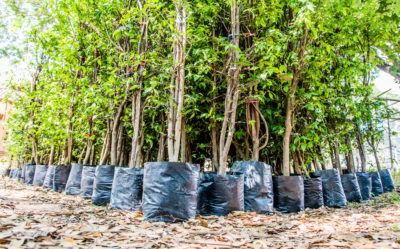Trees are a large investment for your home. They provide shade, shelter, and food for wildlife, and can help reduce your home’s energy bills when placed in the right locations. As we say, “The right tree in the right place.”
Up Next: 4 Tips For Planting Trees In The Winter
Transporting trees big and small from the nursery to your home or place of business is a task that must be handled with care, lest the tree becomes damaged or overly stressed.
Never Pick Trees Up By Their Trunk

Rather, lift and carry it by the root ball or the pot it is in. Carrying a tree by its trunk can strip the bark and injure it. Whenever possible, use a dolly or a wheelbarrow to move trees. Be careful not to drop the tree and damage the root ball!
Break Out The Tarp & Bungee Cords
Yes, you will need some tarp and bungee cords or rope when you transport your trees in a vehicle.
Lay the trees down in the bed of the truck to avoid stress and damage from wind, gently securing them with rope and tarp to avoid sliding. If you have to put the cords on the trunk, wrap the trunk with a towel to prevent chafing and damage.
Keep The Vehicle Climate Controlled
If the trees you are transporting are in a closed truck bed or vehicle, remember to keep the cabin climate controlled. Keeping young trees in a closed space like a hot vehicle for too long will cause them to wilt.
Plant The Day Of Transport
The day you transport your trees to their planting site, they should be planted right then and there to prevent deterioration. If they cannot be planted upon arrival, be sure to keep them irrigated and kept in a holding area that is shaded and away from the wind. This area should be set up in advance.
Keep the sides of the root balls covered with mulch to protect them from drying out and be sure to keep them watered until you plant. After planting, water well to help offset transplant shock.
